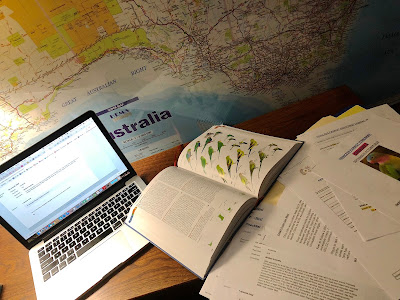Somehow the Tasmanian Boobook (Morepork) had slipped by me. Earlier this year, I realised that I did not have it on my list. I had no Tassie trips planned for the immediate future, but I knew that these owls were seen consistently at Cape Liptrap Lighthouse in Victoria around mid October. I talked about it with my birding buddy James Cornelious. He had seen them there last year.
On Sunday 7 October, my friends Murray and Charlie Scott from Brisbane were down in Victoria and James and I took them around the WTP. This day of birding ended up including two quite confiding Orange-bellied Parrots. These released birds posed nicely for photos. Murray and Charlie were very pleased indeed.
The previous Morepork reports started in mid October, with the 14th being the earliest listed on eBird. But James had seen an Instagram post by James Mustafa from 5 October. It seems that he, Sue Taylor, and another birder had seen the owls on the fifth. Since James was already down in Lara, we decided if he stayed the night, we could drive over the next day to Cape Liptrap. We had a plan.
I did not want to drive back late at night, so I decided to book an off-season cabin at Waratah Bay Caravan Park just 20 minutes from the lighthouse. At least in off-season, I highly recommend this park. The views are wondrous! We had a two-bedroom cabin that was very comfortable and reasonable. Honestly, I could have done with a few days there.
I had phoned my friend, Dave Stabb and found that he needed the Morepork as well. He only lives about an hour from the lighthouse. He decided to meet us there at 6pm. I even had time for a short ‘granddaddy nap’ in the cabin before we left to meet him.
On the drive over, even in full daylight, we had to mind the Wombats. We saw several, especially on the last ten kilometres of unsealed road. We arrived at the carpark, met Dave and walked down to the lighthouse. I was surprised at how close it was. It is just a couple hundred metres of flat, easy path. At the lighthouse there are two picnic tables, one on the left and one on the right. This was going to be pretty easy birding.
As we waited for darkness some young (late teen, early twenties) ‘kids’ arrived carrying things including several six-packs of beer. They then set up a small beach-type tent right there on the lighthouse grounds. More came, and then a few more. We were very worried that this impending ‘party’ would be noisy and affect the owls behaviour. Even though there eventually must have been at least a score of them wandering around and hanging out in their tent, they were not loud at all. Honestly, we hardly knew they were there.
The first owl flew over us just after dusk. We then saw another couple before it was full dark including one that I caught in the torch beam giving us decent enough views to tick the bird. We sat down at the left picnic table (facing the lighthouse) to wait for more and then… a Morepork landed on Dave’s head! Absolutely silent, it landed momentarily on his head less than a metre away from me and I did not hear or see a thing! (I was looking down checking my camera, as I had tripped and fallen with it earlier). James was sitting right beside Dave and saw the bird. Dave felt it land lightly and depart, but that was all. I mean seriously, on his head!
After sitting a bit longer at the left table, we decided to move to the table on the right side. It seemed the owls where coming from the left. It was now full dark. Every so often I’d wander away from the table and shine the red torchlight along the posts and into the trees and brush. On the third or forth of these wanders there it was, eye shine! Two eyes were staring back at me. I called to Dave and James and soon we were all looking at the Tasmanian Boobook. We took a few photos using only the medium torchlight and marvelled at the lovely little owl. And they are small too. Then we switched off the torch and left it be.
We took a lifer selfie for Dave and me and said goodbye to him. Then we drove slowly back to Waratah Bay. I lost count of Wombats along the way (nine or ten maybe?). We were in our comfy cabin by quarter past ten. That was my kind of nocturnal birding.
The next morning I was happily up at dawn and enjoyed a short walk. The weather was turning rainy, and after looking at a beautiful female Helena Gum Moth, we packed up and left. Sadly, only a few minutes later, the moth was snatched up by a magpie and devoured. Such can be nature.

























































